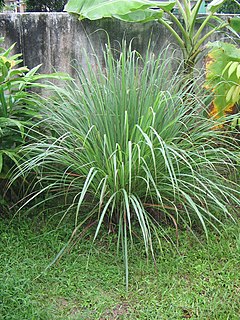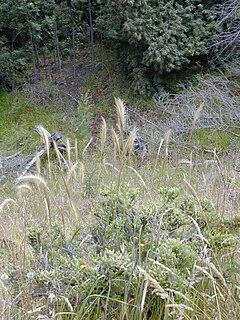
Cymbopogon, also known as lemongrass, barbed wire grass, silky heads, Cochin grass, Malabar grass, oily heads or fever grass, is a genus of Asian, African, Australian, and tropical island plants in the grass family. Some species are commonly cultivated as culinary and medicinal herbs because of their scent, resembling that of lemons . The name cymbopogon derives from the Greek words kymbe and pogon "which mean [that] in most species, the hairy spikelets project from boat-shaped spathes."

The phylum Bacteroidetes is composed of three large classes of Gram-negative, nonsporeforming, anaerobic or aerobic, and rod-shaped bacteria that are widely distributed in the environment, including in soil, sediments, and sea water, as well as in the guts and on the skin of animals.

The golden samphire is a perennial coastal species, which may be found growing on salt marsh or sea cliffs across western and southern Europe and the Mediterranean.

Polypodiaceae is a family of ferns. In the Pteridophyte Phylogeny Group classification of 2016, the family includes around 65 genera and an estimated 1,650 species and is placed in the order Polypodiales, suborder Polypodiineae. A broader circumscription has also been used, in which the family includes other families kept separate in PPG I. Nearly all species are epiphytes, but some are terrestrial.

Coprosma is a genus of flowering plants in the family Rubiaceae. It is found in New Zealand, Hawaiian Islands, Borneo, Java, New Guinea, islands of the Pacific Ocean to Australia and the Juan Fernández Islands.

Cleroidea is a small superfamily of beetles containing about 10,000 species. Most of the members of the group are somewhat slender, often with fairly soft, flexible elytra, and typically hairy or scaly.

Bocquillonia is a plant genus of the family Euphorbiaceae first described as a genus in 1862. The entire genus is endemic to New Caledonia. Molecular phylogenetic analyses suggest that Bocquillonia is nested in Alchornea.
The Sinitic languages, often synonymous with the Chinese languages, constitute the major branch of the Sino-Tibetan language family. It is frequently proposed that there is a primary split between the Sinitic languages and the rest of the family, but this view is rejected by an increasing number of researchers. The Bai languages, whose classification is difficult, may be an offshoot of Old Chinese and thus be Sinitic; otherwise Sinitic is defined by the many varieties of Chinese and usage of the term "Sinitic" may reflect the linguistic view that Chinese constitutes a family of hundreds of distinct languages, rather than dialects of a single language.

Pancratium is a genus of African and Eurasian perennial, herbaceous and bulbous plants in the Amaryllis family, subfamily Amaryllidoideae

Koeleria is a common and widespread genus of plants in the grass family, found on all continents except Antarctica and on various oceanic islands. It includes species known generally as Junegrasses.

The Paleotropical Kingdom (Paleotropis) is a floristic kingdom comprising tropical areas of Africa, Asia and Oceania, as proposed by Ronald Good and Armen Takhtajan. Part of its flora, inherited from the ancient supercontinent of Gondwana or exchanged later, is shared with the Neotropical Kingdom, comprising tropical areas of Central and South America. Moreover, the Paleotropical flora influenced the tropical flora of the Australian Kingdom. The Paleotropical Kingdom is subdivided into five floristic subkingdoms according to Takhtajan and about 13 floristic regions. In this article the floristic subkingdoms and regions are given as delineated by Takhtajan.

Glyceria is a widespread genus of grass family common across Eurasia, Australia, North Africa, and the Americas.

Asteroideae is a subfamily of the plant family Asteraceae. It contains about 70% of the species of the family. It is made of several tribes, including Astereae, Calenduleae, Eupatorieae, Gnaphalieae, Heliantheae, Senecioneae and Tageteae. Asteroideae contains plants found all over the world, many of which are shrubby. There are about 1,135 genera and 17,200 species within this subfamily; the largest genera by number of species are Helichrysum (500-600) and Artemisia (550). Asteroideae is said to have begun approximately 46-36.5 million years ago.

Ampelodesmos is a genus of Mediterranean plants in the grass family, which is known by the common names stramma, Mauritania grass, rope grass, and dis grass. It is classified in its own tribe Ampelodesmeae within the grass subfamily Pooideae.

Periballia is a genus of Mediterranean plants in the grass family.

Apluda is a genus of plants in the grass family native to Asia and to various islands in the Indian and Pacific Oceans.
Triplachne is a genus of seaside plants in the grass family, native to shorelines in the Mediterranean region from the Canary Islands to Turkey. The only known species is Triplachne nitens, called shining grass. It is native to Spain, Portugal, Sicily, Greece, Algeria, Morocco, Libya, Tunisia, Egypt, Turkey, Cyprus, Palestine, Israel.

Dichelachne is a genus of Australian, Indonesian, and Pacific Island plants in the grass family. They are known commonly as plumegrasses.

Placospermum is a genus of a single species of large trees, constituting part of the plant family Proteaceae. The species Placospermum coriaceum is endemic to the rainforests of the wet tropics region of northeastern Queensland, Australia. Common names include rose silky oak and plate-seeded oak.
Gagea granatellii is a Mediterranean and Black Sea species of plants in the lily family. It is native to Spain incl. Balearic Islands, France incl. Corsica, Italy, Libya, Greece, Romania, and Crimea.















